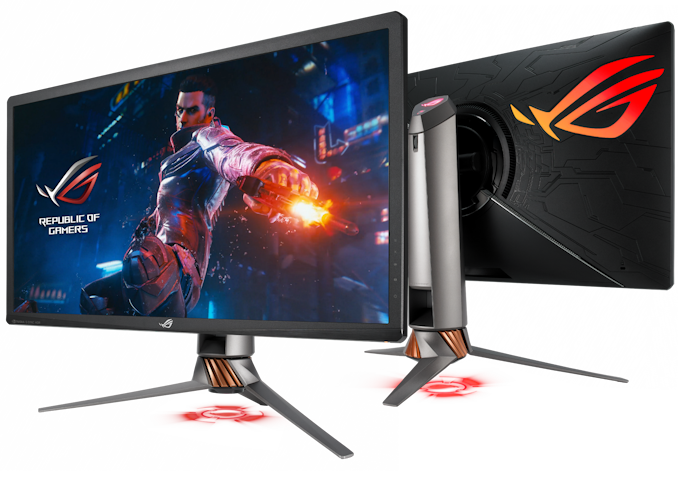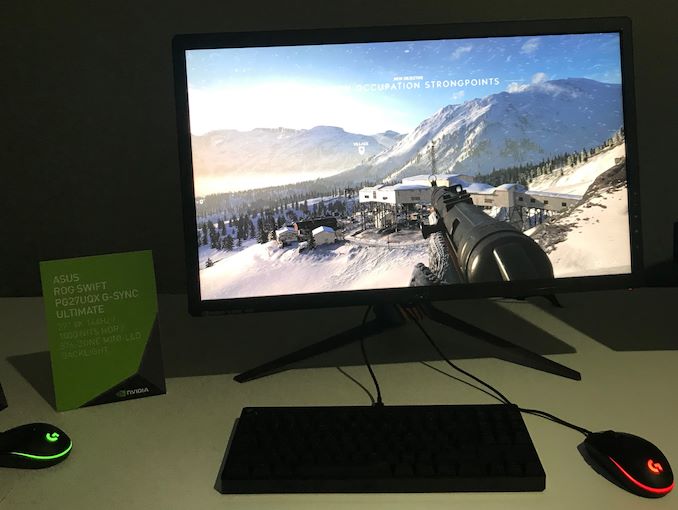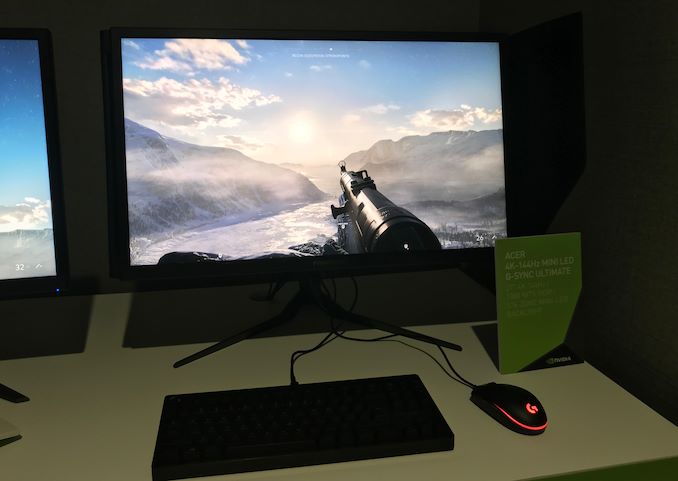NVIDIA G-Sync Ultimate Mini LED Monitors: From Acer & ASUS Later in 2019
by Anton Shilov on June 18, 2019 3:15 PM EST- Posted in
- Displays
- Acer
- Asus
- Trade Shows
- NVIDIA
- G-Sync
- G-Sync HDR
- Computex 2019

Known for its ability to build ecosystems around its products, NVIDIA rolled out a updated display-related initiative at this year’s Computex trade show. With the recent advent of commercial-scale miniaturized LEDs (Mini LEDs), NVIDIA and its partners are putting together a new generation of G-Sync Ultimate (HDR) monitors incorporating the smaller LEDs for use as backlighting. Similar to 2018's first-generation G-Sync Ultimate monitors, NVIDIA is working with Acer and ASUS on the monitors, which will pair a Mini LED-based (and quantum dot enhanced) backlighting system with 144 Hz IPS LCD panels. These 4K 27-inch LCDs are looking to iterate on previous designs by offering an even greater number of LED backlighting zones, further improving the monitors' contrast and reducing the remaining backlight bloom.
Monitors based on the company’s Mini LED reference design will initially be available from Acer and ASUS. These 27-inch displays will feature a 576-zone Mini LED-based backlighting system, which is a 50% increase in zones over the first-generation 384-zone designs. And, like their predecessors, these new monitors will incorporate Full Array Local Dimming (FALD) for fine-grained backlighting control and improved contrast, and a quantum dot film layer for wide color reproduction. Specific color gamut coverage levels haven't been announced, but NVIDIA has confirmed that these monitors will peak at 1000 nits brightness (in HDR mode), the same as the earlier monitors. Past that, we're looking at the same general specs as the first-gen displays, with a 3840x2160 resolution panel that can go up to 144 Hz.
The big question, of course, is pricing and availability. While NVIDIA is only responsible for the reference design and, officially at least, is deferring to Acer and ASUS on retail details, the company is all but promising that the Mini LED-based monitors will reach store shelves this year. As for pricing, that remains to be seen. The first-generation monitors already carried a hefty price tag of around $2000, and while this is a premium market, even higher price tags for the Mini LED Predator and ROG Swift PG27UQX may be hard to swallow. So hopefully Acer and ASUS are able to get these monitors on to the market at the same point where the first-generation monitors will leave off.
Related Reading:
Source: NVIDIA












32 Comments
View All Comments
Guspaz - Thursday, June 20, 2019 - link
tl;dr: Why don't they just track subpixel aging and then dim the other pixels to match so that the image is always uniform?One thing I don't understand is why OLED panels don't do per-subpixel lifespan tracking with adapting dimming as one of the several techniques to avoid burn-in. OLED subpixels age at a predictable rate based on time, intensity, and colour, right? So why not track the total amount of light emitted by each OLED subpixel and then adjust the brightness of the entire screen on a per-subpixel basis to compensate? That way, instead of burn-in, you'd just decrease the overall brightness of the screen a bit so that the image was uniform.
It doesn't seem like it'd be that hard either, assign a weighted 8-bit aging value to each subpixel in each frame, and then accumulate the values for every frame in a 64-bit-per-subpixel non-volatile buffer. At 4K120 with four subpixels per pixel (as I believe LG TV panels are), that should be enough for roughly 167 billion operating hours of data in a ~256MB buffer. Then that data can also be used to generate a brightness map for the screen for compensation.
You don't need to write the data every frame, just keep the running tally in RAM and then write it periodically to SLC or something. Or hell, write it every frame to optane, it's not like 256MB of anything costs much.
halcyon - Wednesday, June 19, 2019 - link
LG already sells a 38" "1ms" IPS no-Gsync, faux-HDR screen for $2000USD. That is ridiculous.At least these monitors have:
- guaranteed/tested low latency
- True HDR
- FALD
- GSync (Hw) + HDR both on
Unlike the LG basic high refresh rate IPS screen
zodiacfml - Wednesday, June 19, 2019 - link
Same thoughts. I'd rather take LG's flagship OLED TV with HDMI 2.1 and VRR for $2000spkay31 - Tuesday, June 18, 2019 - link
Far too small a display to appreciate the 4K resolution. I would be interested in a curved 40" or 43" display with these specs.Cygni - Tuesday, June 18, 2019 - link
The big questions for me are a) have they fixed the DP bandwidth problem that lead to chroma subsampling over 120hz [unfortunately it doesn't look like it], and b) have they gotten rid of the awful fan [unfortunately it doesn't look like it]This is unfortunately a disappointing second generation until they can fix those problems.
Sefem - Wednesday, June 19, 2019 - link
a)There's nothing to fix (nothing broke), it's a limitation of the DP protocolb)The FALD (and its driver) need to be cooled or they will damage the panel and themselves, the driver cold be "easily" passively cooled, the FALD I'm not so sure
Bensam123 - Wednesday, June 19, 2019 - link
This isn't a gaming monitor, this would be better suited for a TV. Higher refresh (beyond 240), lower response times, 0 input lag, sync technology... These are a few of our favorite things. Then you throw all the other bells and whistles at it, like 4k.Slashchat - Wednesday, June 19, 2019 - link
i got banned in forum and i cant contact the admin, the site is bloked, please anandtech, reactivate my account, it was a simple failure of me! please help me! i will not do the post again. thank you!jabbadap - Wednesday, June 19, 2019 - link
Are these still active cooled?peevee - Thursday, June 20, 2019 - link
"576-zone Mini LED-based backlighting system"Give me 1920x1200x3 hard color-specific LEDs already.